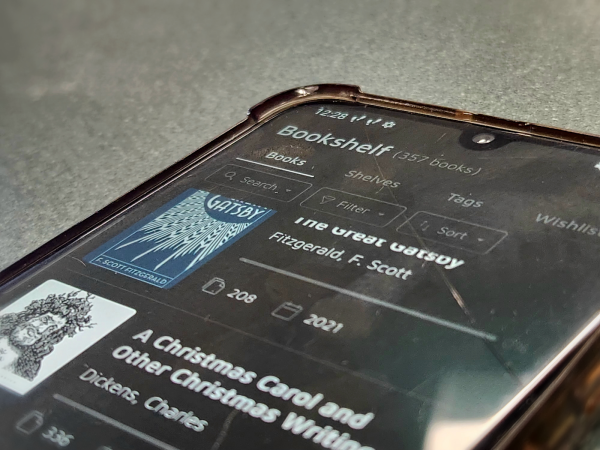Goodbye Gluten

Lombardi munching on a gluten-free cookie.
March 7, 2016
At the beginning of her junior year Marisa Lombardi was supposed to be transitioning back into the groove of school. Classes. Sports. Clubs. She was supposed to be cruising into her third year of high school, but her health suddenly became a detour.
Starting in September Lombardi began feeling a loss of appetite, nausea, and an inability to keep down food. These symptoms led her to have trouble staying awake. She was weak. After three weeks of feeling sick Lombardi finally visited her pediatrician.
Her pediatrician initially believed that she had Crohn’s disease, a chronic inflammatory bowel disease that affects the lining of the digestive tract. To test for this her doctor sent her to get her blood taken. When her labs came back her blood was negative for this disease.
“I was relieved that my blood test returned negative for Crohn’s,” says Lombardi.
After she tested negative for Crohn’s her pediatrician sent her to a gastroenterologist, which is a physician who specializes in diseases of the digestive system. When she met with this doctor he ordered Lombardi to get an endoscopy and colonoscopy. These two procedures involve a tiny camera going through the body to view the stomach and colon.
“The whole process of testing scared me,” says Lombardi. “It made me nervous that they couldn’t tell me what was wrong right away.”
Lombardi’s results from these procedures indicated that she had irritable bowel syndrome, or IBS, an intestinal disorder causing pain in the stomach. This prognosis finally led Lombardi to the last doctor she would have to visit. Her “gastro” sent her to a nutritionist.
The nutritionist explained that the common triggers for IBS are gluten and dairy. “She basically told me to stop eating gluten and see if I feel better,” says Lombardi.
After meeting with the nutritionist in November she has cut gluten (proteins found in wheat) out of her diet entirely; yes, even pasta. While this might seem difficult for linguini lover Lombardi, she has found it “not as hard as expected.”
“After learning I couldn’t eat foods with gluten in them I literally thought my life was over,” laughed Lombardi.
In the beginning she researched what was and wasn’t gluten-free. To her surprise she discovered that bread had gluten in it. While many find this obvious Lombardi was “in shock.”
At first it was hard for her to find substitutes for her favorites like goldfish and VitaTop muffins. The half aisle of gluten-free products in the Ludlow Big Y wasn’t enough. Her mom then started taking her to the Wilbraham Big Y which had a bigger selection of gluten-free foods.
“The extra five minute drive it takes to get to the Wilbraham Big Y was not a problem for me,” says mother Danielle Lombardi, “It was worth it for the better selection of foods.”
But Lombardi did not realize the vast options of gluten-free products until she began shopping at Trader Joe’s in South Hadley. Trader Joe’s is known for its high selection of gluten-free foods.
“This store is heaven for me,” she says, “I now buy all of my food from there.”
Another favoring aspect of Trader Joe’s is the cost. It offers cheaper gluten-free products compared to grocery stores like Whole Foods and Big Y.
Her favorite buy from Trader Joe’s is the gluten-free bread. “It is the only gluten-free bread I’ve tried that doesn’t taste like cardboard,” says Lombardi.
This is a blessing for her considering that her food staples include bread and pasta. She said it makes her sad that her two favorite foods are “the grossest gluten-free.”
While finds from Trader Joe’s are nice, eating gluten-free is not always convenient. When she is out and about it is hard for her to find foods to eat. But this dilemma has opened Lombardi up to eating fresher foods. “I am constantly eating fruits and salad now,” she says.
The inconvenience isn’t even the hardest part for Lombardi. The worst part about eating gluten-free is when she goes out to dinner with her friends.
“It makes me sad when all of my friends are eating yummy foods that I can’t,” she says, “So sometimes I give in and have pizza with my friends or something.”
She cheats about once a week. These meals do make Lombardi feel sick but it is “so worth it.”
Her favorite place to indulge in gluten goodness is Panera Restaurant. “Panera mac-and-cheese has my heart,” she says. Along with the mac-and-cheese Lombardi finishes off her meal with a warm, gooey chocolate chip cookie which is “the size of her face.”
Another one of her favorite places to cheat is Moe’s. When she eats here she only considers it a “small” cheat because of the low level of gluten in her meal. Lombardi’s favorite mexican cuisine at Moe’s is a chicken and cheese quesadilla dunked in sour cream and guacamole. “My stomach usually feels decent after Moe’s because the only gluten involved is the tortilla,” says Lombardi.
Even though Lombardi uses eating out as a time to cheat there are some restaurants that make it easy for her stay on track. Many restaurants now offer gluten-free friendly sections on the menu.
Her favorite gluten-free menu is at Pizzeria Uno’s. “They definitely have the best selection and for a good price,” she says. Her favorites include grilled chicken or salmon with veggies.
This is one of the best places for her and her friends to go to because it offers lots of options for not only her friends but Lombardi as well.
Her friends may have the freedom to eat whatever they’d like from bread to brownies but Lombardi advises them to lower their gluten intake.
“Even though they don’t have what I have they still complain of upset stomachs after eating high gluten meals,” says Lombardi. She believes that these stomach aches are caused by gluten.
She warns that “their allergy may not be as severe but they do exist and should be taken care of.” One friend in particular has taken her thoughts into consideration. Junior Carley Moniz suffers tremendously from the stomach problems listed above and after talking to Lombardi she hasn’t stopped eating gluten, but has lowered her intake.
“I can definitely tell the difference when I don’t eat gluten for a couple days compared to when I do,” says Moniz, “It’s crazy how simply cutting out certain foods has made my stomach feel better.”
Lombardi has used her disorder to help others, discussing it openly. “I can imagine that many people with this problem may hide it from their classmates but I don’t see the big deal,” she says, “It is kind of gross but it is a part of my life now.”
Her mother is so proud of “how mature Marisa has been throughout this process.”
While Lombardi is unclear on how long she will have to continue eating this way she isn’t in a rush to end it. Even before all of the doctors and sicknesses she realized that gluten has always been a discomfort to her. “It just took me not being able to keep food inside my body to realize,” says Lombardi.
She believes since now the “case is closed” she can finally move forward and enjoy her junior year. Classes. Sports. Clubs. She can settle into her third year of high school, gluten-free.











